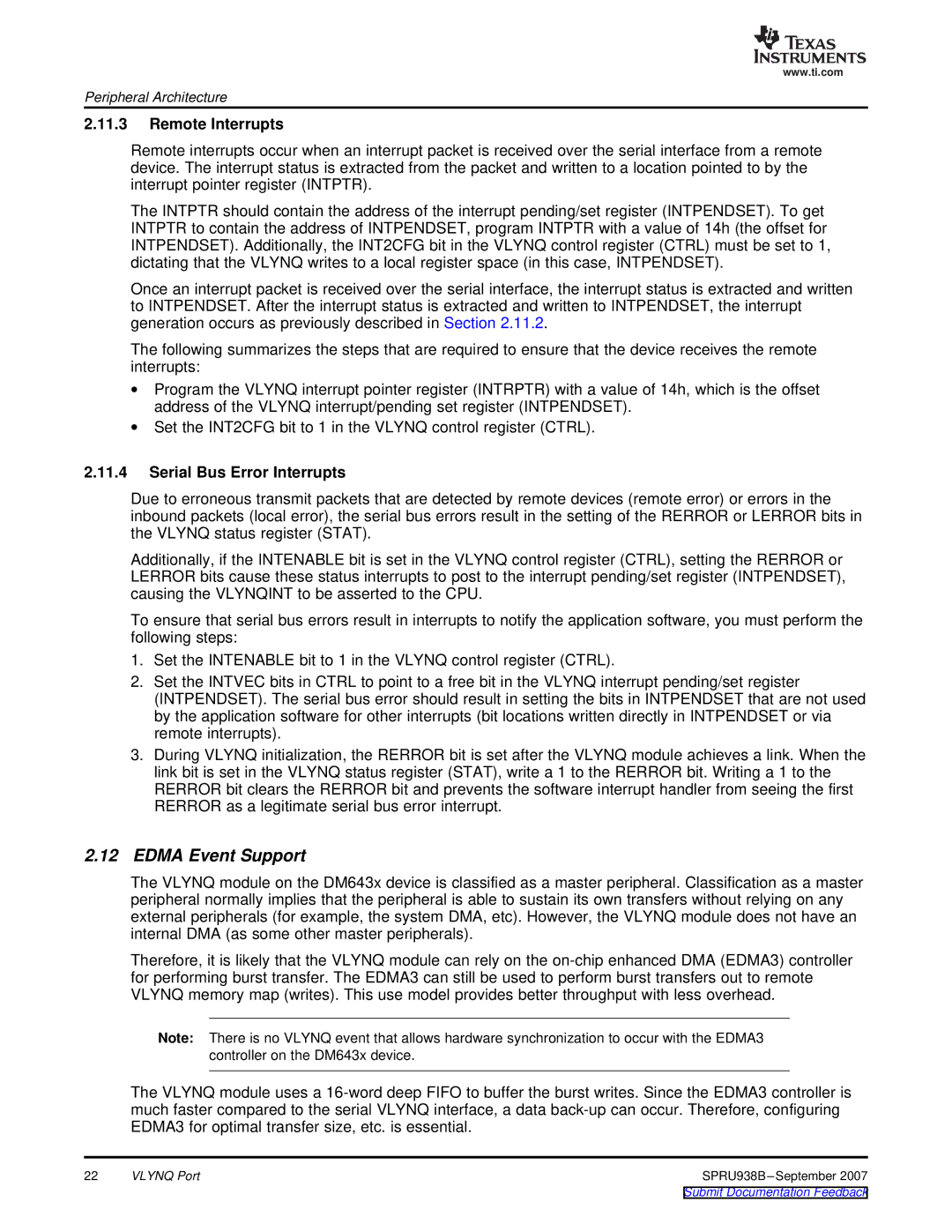
www.ti.com
Peripheral Architecture
2.11.3Remote Interrupts
Remote interrupts occur when an interrupt packet is received over the serial interface from a remote device. The interrupt status is extracted from the packet and written to a location pointed to by the interrupt pointer register (INTPTR).
The INTPTR should contain the address of the interrupt pending/set register (INTPENDSET). To get INTPTR to contain the address of INTPENDSET, program INTPTR with a value of 14h (the offset for INTPENDSET). Additionally, the INT2CFG bit in the VLYNQ control register (CTRL) must be set to 1, dictating that the VLYNQ writes to a local register space (in this case, INTPENDSET).
Once an interrupt packet is received over the serial interface, the interrupt status is extracted and written to INTPENDSET. After the interrupt status is extracted and written to INTPENDSET, the interrupt generation occurs as previously described in Section 2.11.2.
The following summarizes the steps that are required to ensure that the device receives the remote interrupts:
∙Program the VLYNQ interrupt pointer register (INTRPTR) with a value of 14h, which is the offset address of the VLYNQ interrupt/pending set register (INTPENDSET).
∙Set the INT2CFG bit to 1 in the VLYNQ control register (CTRL).
2.11.4Serial Bus Error Interrupts
Due to erroneous transmit packets that are detected by remote devices (remote error) or errors in the inbound packets (local error), the serial bus errors result in the setting of the RERROR or LERROR bits in the VLYNQ status register (STAT).
Additionally, if the INTENABLE bit is set in the VLYNQ control register (CTRL), setting the RERROR or LERROR bits cause these status interrupts to post to the interrupt pending/set register (INTPENDSET), causing the VLYNQINT to be asserted to the CPU.
To ensure that serial bus errors result in interrupts to notify the application software, you must perform the following steps:
1.Set the INTENABLE bit to 1 in the VLYNQ control register (CTRL).
2.Set the INTVEC bits in CTRL to point to a free bit in the VLYNQ interrupt pending/set register (INTPENDSET). The serial bus error should result in setting the bits in INTPENDSET that are not used by the application software for other interrupts (bit locations written directly in INTPENDSET or via remote interrupts).
3.During VLYNQ initialization, the RERROR bit is set after the VLYNQ module achieves a link. When the link bit is set in the VLYNQ status register (STAT), write a 1 to the RERROR bit. Writing a 1 to the RERROR bit clears the RERROR bit and prevents the software interrupt handler from seeing the first RERROR as a legitimate serial bus error interrupt.
2.12EDMA Event Support
The VLYNQ module on the DM643x device is classified as a master peripheral. Classification as a master peripheral normally implies that the peripheral is able to sustain its own transfers without relying on any external peripherals (for example, the system DMA, etc). However, the VLYNQ module does not have an internal DMA (as some other master peripherals).
Therefore, it is likely that the VLYNQ module can rely on the
Note: There is no VLYNQ event that allows hardware synchronization to occur with the EDMA3 controller on the DM643x device.
The VLYNQ module uses a
22 | VLYNQ Port | SPRU938B |
